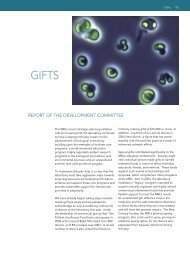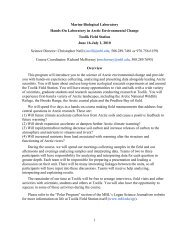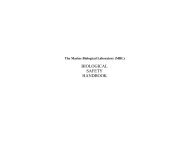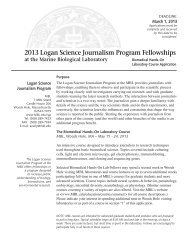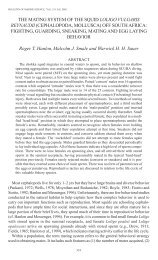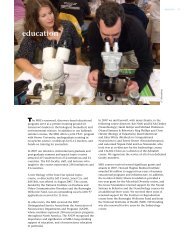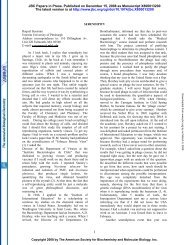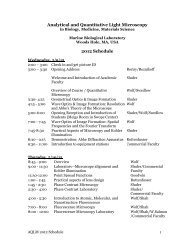An Ethogram of Body Patterning Behavior in the Biomedically and ...
An Ethogram of Body Patterning Behavior in the Biomedically and ...
An Ethogram of Body Patterning Behavior in the Biomedically and ...
Create successful ePaper yourself
Turn your PDF publications into a flip-book with our unique Google optimized e-Paper software.
52 R. T. HANLON ET AL.<br />
Table I<br />
<strong>Body</strong> patterns <strong>and</strong> <strong>the</strong>ir components <strong>in</strong> <strong>the</strong> squid Loligo pealei; compare Figure I<br />
Light:<br />
1. Clear<br />
2. White arms/head<br />
3. White dorsal stripe<br />
4. Accentuated testis (m)<br />
5. Accentuated oviducal gl<strong>and</strong> (f)<br />
Iridescent:<br />
6. Dorsal mantle collar iridophores<br />
7. Iridescent sclera<br />
8. Dorsal iridophore splotches<br />
9. Iridescent arm stripes<br />
10. Dorsal iridophore sheen<br />
Light polarization components:<br />
1. Polarized arms<br />
2. Sk<strong>in</strong> surface polarization<br />
3. Polarized eyes<br />
4. Polarized dorsal sheen<br />
BODY PAlTERNS<br />
Chronic (m<strong>in</strong> to hours) Acute (seconds)<br />
1. Basic Amber Pattern 1. Very Dark<br />
2. Clear <strong>Body</strong> Pattern 2. Blanch-Ink-Jet Maneuver<br />
3. Countershad<strong>in</strong>g 3. Lateral Display<br />
4. Chronic All Dark 4. Mate Guard<strong>in</strong>g Pattern<br />
5. B<strong>and</strong>ed Bottom Sitt<strong>in</strong>g 5. Accentuated Testis<br />
6. Chronic Bright White Pattern<br />
(861)<br />
(76%<br />
(194)<br />
(1179)<br />
(183)<br />
(SlooO)<br />
(167)<br />
(5w<br />
(338)<br />
(32)<br />
COMPONENTS*<br />
Chromatic<br />
Locomotor<br />
1. Ink<strong>in</strong>g<br />
2. Jett<strong>in</strong>g/flee<strong>in</strong>g<br />
3. Chas<strong>in</strong>g<br />
4. Bottom sitt<strong>in</strong>g<br />
5. Egg touch<strong>in</strong>g<br />
6. Parallel position<strong>in</strong>g<br />
7. Jockey<strong>in</strong>g <strong>and</strong> parry<strong>in</strong>g (m)<br />
8. F<strong>in</strong> beat<strong>in</strong>g (m)<br />
9. Forward lunge/grab (m)<br />
10. Male-parallel mat<strong>in</strong>g<br />
11. Head-to-head<br />
12. Oviposition<br />
mat<strong>in</strong>g<br />
Postural<br />
1. Raised -<br />
2. Splayed arms<br />
3. Droop<strong>in</strong>g arms<br />
4. Raised & splayed arms<br />
Dark:<br />
1. All dark<br />
2. Dark arms/head<br />
3. Dark head<br />
4. Dark dorsal stripe<br />
5. Ventral mantle snipe<br />
6. Mantle marg<strong>in</strong> stripe.<br />
7. Dark arm stripes<br />
8. F<strong>in</strong> spots<br />
9. Arm spots<br />
10. Infraocular spot<br />
11. B<strong>and</strong>s<br />
12. Shaded eye<br />
13. Dark f<strong>in</strong>s<br />
14. Dark posterior mantle<br />
15. Shaded testis (m)<br />
16. Shaded oviducal gl<strong>and</strong> (f)<br />
17. Red accessory nidamental gl<strong>and</strong> (f)<br />
18. Lateral mantle spot (f)<br />
19. Lateral blush (f)<br />
20. Weak lateral flame (m)<br />
(12)<br />
(336)<br />
(17)<br />
(45)<br />
(120)<br />
(435)<br />
(62)<br />
(93)<br />
(206)<br />
(59)<br />
(24)<br />
(==3@J)<br />
(1065)<br />
W’)<br />
(54)<br />
(560)<br />
5. Flared arms (30)<br />
* Letters <strong>in</strong> paren<strong>the</strong>ses <strong>in</strong>dicate that <strong>the</strong> component is sex-specific: f = female; m = male. Numbers <strong>in</strong>dicate. how many times each component was<br />
observed on video or <strong>in</strong> laboratory trials.<br />
(14w<br />
(133)<br />
(853)<br />
(47)<br />
06%<br />
(283)<br />
(38)<br />
(195)<br />
(672)<br />
(129)<br />
(153)<br />
(190)<br />
(31)<br />
(42)<br />
(11)<br />
(16)<br />
(400)<br />
(147)<br />
(88)<br />
(13)



